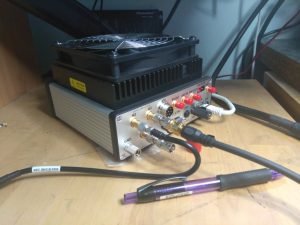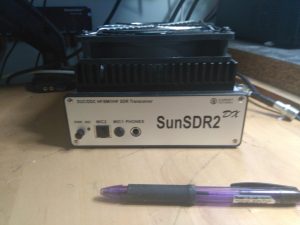I recently got hold of SunSDR2 DX 100W +HF/VHF SDR transceiver
What it is
It does a hell of a lot for its very small size. Unlike the photos on Expert electronic’s website it comes with a 140mm fan fitted to the top of the heatsink. The entire unit is not much bigger than the dimensions of the fan as you can see in these photos.
 |
 |
The fan is completely silent in use and appears thermostatically controlled with varying speeds. On the back panel the unit I received is fitted with a useful looking ground binding post.
An ethernet cable connects to your PC. You have to run the software the manufacturer provides, but it has a lot of features, some of which I am still discovering.
This unit is a higher power version of the the better known SunSDR2 Pro which has been available for a few years. Apart from the power difference, there is apparently better filters and an improved power supply. It certainly doesn’t run hot in use, like people have noted the older unit did. Possibly this is down to the large, but whisper quiet fan mounted on the top.
Technology
The receive signals end up heading into to an ADC (LTC2209) that takes full, 16-bit, samples at a rate of 160Msps (Mega samples per second). These samples contain way too much data to pass straight to a PC so the SunSDR2 DX employs an Altera Cyclone IV FPGA (Field Programmable Gate Array) to decimate the ADC output and deliver chunks of spectrum at a more manageable data rate that can be passed to the PC software for final processing. Two independent decimation feeds are available which means that the software can operate with two entirely independent receivers for split operation anywhere in the tuning range. Management of the band switching, FPGA decimation, SWR bridge and other functions is handled by an LPC1778 Cortex M3 based microcontroller. This controller also links to the on-board 24-bit audio codec that handles the hardware microphone inputs and the phones output. For the transmit section, the IQ transmit signal is generated in the FPGA and passed to an Analog Devices AD9957 1Gsps, 14-bit digital to analogue converter (DAC). In this case, the DAC runs with a 640MHz clock thus allowing 640Msps for a high quality transmit signal.
Features
The system is a Russian design and the hardware itself is manufactured in Taiwan. Some of the features are set out here:
- Independent RX path based on DDC (Direct Down-Conversion) architecture
- Independent TX path based on DUC (Direct Up-Conversion) architecture
- Output power: 100W on HF, 50W on 6M and 8W on 2M ·
- 2 software RXs + SubRX for each of them (4 slices total) + independent wideband Bandscope up to 80 MHz
- Remote control operation
- TCI interface for connection with third-party software
- TX processing module provides advanced tuning capability for voice operation
- ExtCTRL connector to control external devices with 8 powerful keys with open collector
- ALC connector for external power amplifiers
- Supports use of VHF transverters (coming soon)
- An opportunity to use the transceiver as a signal generator via DAC OUT connector (SMA connector) ·
- An opportunity to use external filters in the middle of the RF path, using ADC IN and RX OUT (SMA connector) ·
- A small delay in CW mode (about 10 ms)
- Input for external 10 MHz reference oscillator ·
- An opportunity to use the transceiver in SO2V mode ·
- Full duplex or half duplex modes (in future) ·
- Antenna switch with 2 HF antenna connectors and separate VHF antenna connector (Mini UHF connectors) ·
- Internal power-meter for HF and VHF bands and SWR-meter for HF band ·
- Ethernet LAN interface to PC
Operational Experience
I’m using it with a small fanless PC, an i7 8565 @1.8GHz with 16GByte RAM and Windows 10. The Expert SDR Software could also run under Linux.(Ubuntu). Setting up was not that complicated, basically setting the right IP addresses for the PC LAN port and connecting a short ethernet cable between the PC and the transceiver. The addendum to the manual is very useful as it goes through how to set up virtual audio cables and virtual com ports to connect to other software packages. I’m using WSJT-X & FLDIGI for datamodes and also Swisslog for logging. FT8 operation is particularly easy with rx and tx audio and CAT control being handled by virtual audio and serial ports. Swisslog also automatically logs FT8 contacts and tracks you band etc
The transceiver will support a Yauseu MH43 mic with an RJ45 connector plugged straight in. In my case however I have the audio coming from the PC. I have an AKG mic feeding an external USB soundcard that also powers the mic (Behringer UMC22) and this seems to work very well. Hours of fun can be had (if you like the sound of your own voice) playing around with the audio on transmit. The unit offers a very large array of equalisation/compression/clipping/bandwidth options and you can save your settings to different named profiles so that different audio characteristics can be selected for say SSB weak-signal, local ragchew, FM operation on 2 or 6m etc etc.

The AKG mic on its boom, in the background the fanless PC can be seen. There are a lot of audio adjustments, but you can monitor your own transmission easily and also record something and re-transmit it and monitor on Hack Green. I noted a recent QSO on 60m AM on 5317kHz was recorded by John, G3YPZ on the Facebook AM Amateur Radio Europe and he seemed to find the transmitted audio fine, so I’m happy.
I’ve linked to John’s facebook post below where you can hear me waffling away in one of the early contacts I had with the Sun SDR2 DX, which was doubly unusual being both on 60m and using good old AM. These are a band and modes which of course I can’t access on either of the other two HF rigs here, my Elecraft K2, or the TS520S, both being too modern for AM (SSB only) but not modern enough for the 60m band!
Posted by John Petters on Sunday, 5 April 2020